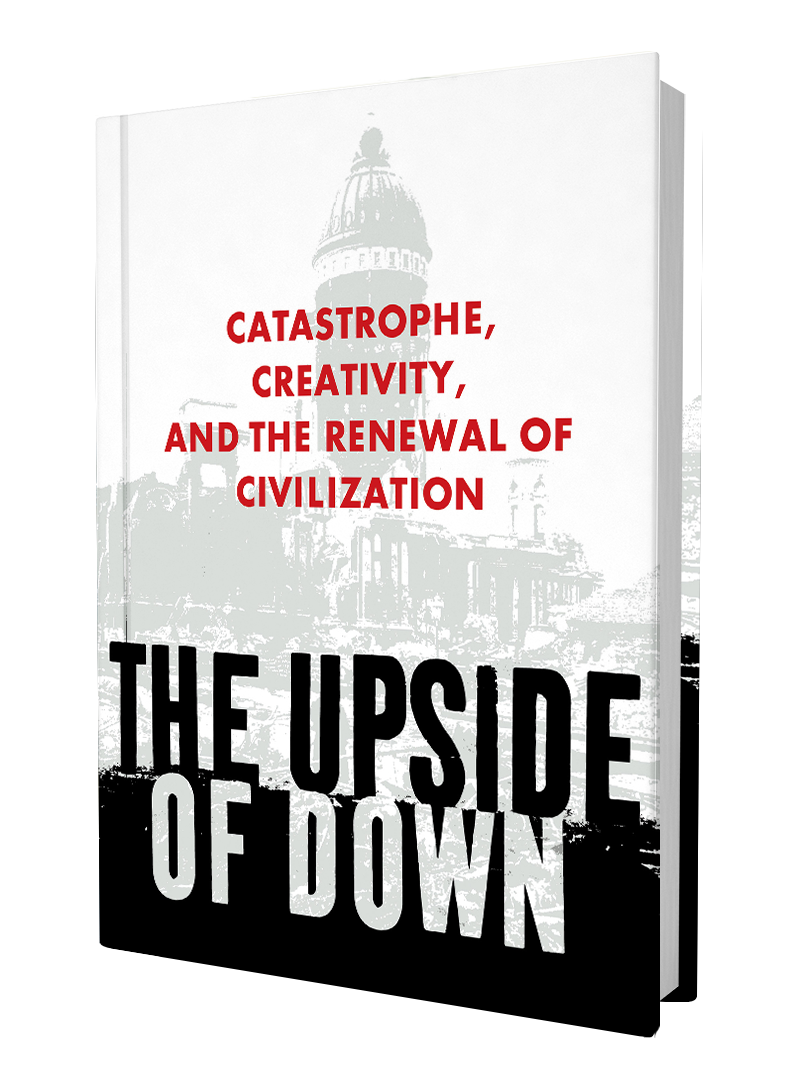the upside of down
The Upside of Down sets out a theory of the growth, crisis, and renewal of societies. Today’s converging energy, environmental, and political-economic stresses could cause a breakdown of national and global order. Yet there are things we can do now to keep such a breakdown from being catastrophic. And some kinds of breakdown could even open up extraordinary opportunities for creative, bold reform of our societies, if we’re prepared to exploit these opportunities when they arise.
This is a groundbreaking, essential book for our times. Thomas Homer-Dixon brings to bear his formidable understanding of the urgent problems that confront our world to clarify their scope and deep causes. The Upside of Down provides a vivid picture of the immense stresses that are simultaneously converging on our societies and threatening a breakdown that would profoundly shake civilization. It shows, too, how we can choose a better route into the future.
With the immediacy that characterized his award-winning international bestseller, The Ingenuity Gap, Homer-Dixon takes us on a remarkable journey – from the fall of the Roman empire to the devastation of the 9/11 attacks in New York, from Toronto in the 2003 blackout to the ancient temples of Lebanon and the wildfires of California. Incorporating the newest findings from an astonishing array of disciplines, he argues that the great stresses our world is experiencing – global warming, energy scarcity, population imbalances, and widening gaps between rich and poor – can’t be looked at independently. As these stresses combine and converge, the risk of breakdown rises. The first signs are appearing in the wastelands of the Arctic, the mud-clogged streets of Gonaïves, Haiti, and the volatile regions of the Middle East and Asia. But while the consequences of denial in our more perilous world are dire, Homer-Dixon makes clear that we can use our emerging understanding of the complex systems in which we live to avoid catastrophic collapse in a way the Roman empire could not.
This vitally important new book shows how, in the face of breakdown, we can still provide for the renewal of our global civilization. We are creating the conditions for catastrophe, but by understanding the underlying principles that make human and natural systems resilient – and by working together to put those principles into effect – we can still limit the severity of collapse and foster regeneration, innovation, and renewal.
Excerpt
San Francisco, Thursday, April 19, 1906
The wind had shifted. Now the inferno turned its attention westward. Block by block, it savaged some of the city’s finest houses. As the mayor, chief of police, and members of the municipal council retreated from building to building before the flames, they decided the city would make one last stand.
The final line of defense, they announced, would be Van Ness Avenue — a broad residential boulevard bisecting San Francisco from north to south. The street lay directly in the fire’s path: if they could use it as a firebreak, they might be able to halt the advance. But if this last effort failed, what remained of the city would surely be lost.
Early the previous day, an enormous earthquake had shattered the city’s core, snapping cast-iron water mains like twigs, toppling thousands of chimneys, and upending coal-burning stoves and boilers. Electrical utility poles fell over, bringing down live wires in showers of sparks. Gas lines ruptured. Kerosene and oil poured out of burst fuel tanks. In seconds, sparks and fuel combined, and dozens of fires exploded across the city. Then, energized by the wood in the city’s buildings, small fires coalesced into mighty firestorms. Even when firefighters could maneuver around the piles of earthquake debris in the streets, they found no water in the hydrants.
By noon on the 19th, the fire had destroyed almost ten square kilometers of the city east of Van Ness Avenue. The financial district, Market Street, and the district south of Market were smoking ruins…
Reading from the Prologue of The Upside of Down
Rome
The Upside of Down includes a detailed treatment of the amount of energy needed to build the Roman Colosseum and to run the Roman empire.
Praise For
“Thomas Homer-Dixon [is] one of the best-informed and most brilliant writers on global affairs today.” – Dylan Evans, The Guardian
“Anyone who wants to get serious about the defense of civilization had better read The Upside of Down.” – James Howard Kunstler
“An extraordinarily important book.” – Quill & Quire
“Governments everywhere, from his native Canada to the UK, pay attention to [Homer-Dixon] because the kites he flies are less prone to crashing than most. So his latest book, The Upside of Down, is likely to be read by policy wonks and worried individuals alike. It’s a wake-up call for millions feeling overwhelmed by an unrelieved diet of disaster.” – Ehsan Masood, The New Scientist

